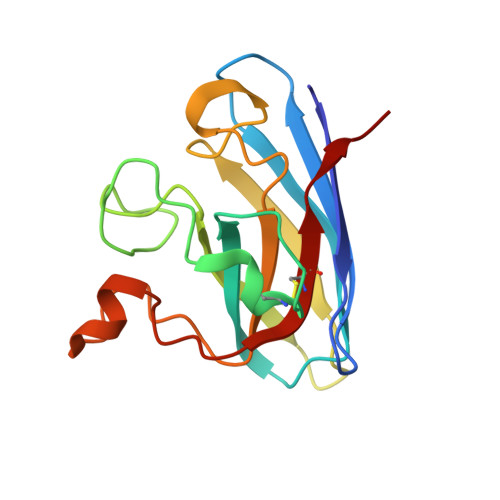Molecular Dynamics Using Atomic-Resolution Structure Reveal Structural Fluctuations that May Lead to Polymerization of Human Cu-Zn Superoxide Dismutase.
Strange, R.W., Yong, C.W., Smith, W., Hasnain, S.S.(2007) Proc Natl Acad Sci U S A 104: 10040
- PubMed: 17548825
- DOI: https://doi.org/10.1073/pnas.0703857104
- Primary Citation of Related Structures:
2V0A - PubMed Abstract:
Mutations of the gene encoding Cu-Zn superoxide dismutase (SOD1) cause 20% of the familial cases of the progressive neurodegenerative disease ALS. A growing body of evidence suggests that in familial ALS (FALS) it is the molecular behavior of the metal-depleted SOD1 dimer that leads to a gain of toxic properties by misfolding, unfolding, and aggregation. Structural studies have so far provided static snapshots on the behavior of the wild-type enzyme and some of the FALS mutants. New approaches are required to map out the structural trajectories of the molecule. Here, using our 1.15-A resolution structure of fully metallated human SOD1 and highly parallelized molecular dynamics code on a high-performance capability computer, we have undertaken molecular dynamics calculations to 4,000 ps to reveal the first stages of misfolding caused by metal deletion. Large spatial and temporal fluctuations of the "electrostatic" and "Zn-binding" loops adjacent to the metal-binding sites are observed in the apo-enzyme relative to the fully metallated dimer. These early misfolding events expose the beta-barrels of the dimer to the external environment, allowing close interactions with adjacent molecules. Protection of the beta-edge of the protein can be partially restored by incorporating a single Zn molecule per dimer. These calculations reveal an essential step in the formation of the experimentally observed self-aggregations of metal-depleted FALS mutant SOD1. This result also has implications for the role of demetallated wild-type SOD1 in sporadic cases of ALS, for which the molecular cause still remains undiscovered.
- Molecular Biophysics Group and Department of Computational Science and Engineering, Science and Technology Facilities Council, Daresbury Laboratory, Warrington, Cheshire WA4 4AD, United Kingdom.
Organizational Affiliation:




















